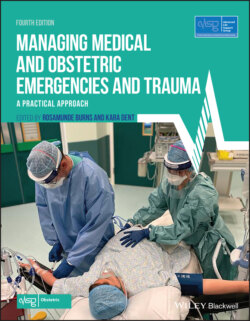Читать книгу Managing Medical and Obstetric Emergencies and Trauma - Группа авторов - Страница 88
Breathlessness
ОглавлениеThis common symptom can arise due to the normal respiratory adaptation to pregnancy, is gradual in onset and is usually noticed by the woman when she is talking or at rest. In normal pregnancy, there is a 40–50% increase in minute ventilation, mostly owing to an increase in tidal volume rather than respiratory rate and this leads to the subjective awareness of breathing. A mild, fully compensated respiratory alkalosis is therefore normal in pregnancy (see Table A5.1 in Appendix 5.1).
However, in any pregnant woman complaining of breathlessness the ‘red flag’ features (Table 5.2) must be sought during history taking and acted upon.
The differential diagnosis of breathlessness in pregnancy includes:
Anaemia
Respiratory causes: asthma, pneumonia, pneumothorax, pulmonary embolus, pulmonary oedema
Cardiac causes: cardiomyopathy, pulmonary hypertension, valvular heart disease
Amniotic fluid embolus
Metabolic (e.g. diabetic ketoacidosis)
Neuromuscular (e.g. myasthenia gravis)
Table 5.2 Red flag symptoms and signs
Source: Adapted from RCP (Royal College of Physicians). Acute Care Toolkit 15: Managing Acute Medical Problems in Pregnancy. London: RCP, 2019. © 2019 Royal College of Physicians
| Breathlessness | Especially if:of sudden onsetworse on lying flatif associated with tachycardia, chest pain or syncoperespiratory rate >20SAO2 <94% or falls to <94% on exertion |
| Headache | Especially if:sudden onset/thunderclap or worst headache everheadache that takes longer than usual to resolve or persists for more than 48 hoursthere are associated fever, seizures, focal neurology, photophobia or diplopiait requires opioids |
| Chest pain | Especially if:pain severe enough to require opioidsradiates to arm, shoulder, back or jawsudden onset, tearing or exertional chest painassociated with haemoptysis, breathlessness, syncope or abnormal neurologyassociated with abnormal observations |
| Palpitations | Especially if:the woman has a family history of sudden cardiac deaththere is structural heart disease or previous cardiac surgeryassociated with syncopeassociated with chest painpersistent severe tachycardia |
| Pyrexia >38°C | Absence of pyrexia does not exclude sepsis, as paracetamol and other antipyretics may temporarily suppress the pyrexia; equally, absence of pyrexia in the presence of sepsis is worrying |
| Abdominal pain | That requires opioids (excluding contractions)Associated with diarrhoea and/or vomiting |
| Reduced or absent fetal movements or fetal heart rate | |
| Uterine (excluding contractions) or renal angle pain or tenderness | |
| Generally unwell especially if distressed and anxious | Signs of a deteriorating condition |
It is important also to remember that because respiratory rate does not increase in normal pregnancy, a rise in respiratory rate will often be the subtle first sign of impending critical illness in pregnancy and should prompt a systematic ABCDE clinical assessment.
